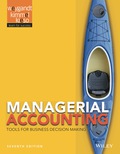
(a)
Direct Material cost:
Direct material cost is the cost of the material which is directly involved in the production. It constitutes the major portion of the total cost of the finished product. For example: The cost of plastic is the direct material for manufacturing a bottle.
To indicate: Whether the cost of a windshield would be classified as direct materials, direct labor, or manufacturing overhead.
(b)
Direct Material cost:
Direct material cost is the cost of the material which is directly involved in the production. It constitutes the major portion of the total cost of the finished product. For example: The cost of plastic is the direct material for manufacturing a bottle.
To indicate: Whether the cost of an engine would be classified as direct materials, direct labor, or manufacturing overhead.
(c)
Direct Labor Cost:
Direct labor cost is the cost of the labor paid to the employees who are directly involved in converting the raw materials to the finished products. It constitutes the major portion of the total cost of the finished product. For example: Wages paid to the mechanic for repairing an automobile.
To indicate: Whether the cost of the wages of the assembly line worker would be classified as direct materials, direct labor, or manufacturing overhead.
(d)
Factory overhead cost is the cost other than the direct material cost, and the direct labor cost which is not directly involved in the production process of converting the raw materials to the finished products. If the direct material cost or direct labor cost does not constitute the major portion of the total cost of the finished product, then it may be classified as the factory overhead cost. For example: Cost of repairing, and maintaining factory equipment.
To indicate: Whether the cost of the
(e)
Factory Overhead Cost:
Factory overhead cost is the cost other than the direct material cost, and the direct labor cost which is not directly involved in the production process of converting the raw materials to the finished products. If the direct material cost or direct labor cost does not constitute the major portion of the total cost of the finished product, then it may be classified as the factory overhead cost. For example: Cost of repairing, and maintaining factory equipment.
To indicate: Whether the cost of the factory machinery lubricants would be classified as direct materials, direct labor, or manufacturing overhead.
(f)
Direct Material cost:
Direct material cost is the cost of the material which is directly involved in the production. It constitutes the major portion of the total cost of the finished product. For example: The cost of plastic is the direct material for manufacturing a bottle.
To indicate: Whether the cost of the tires would be classified as direct materials, direct labor, or manufacturing overhead.
(g)
Direct Material cost:
Direct material cost is the cost of the material which is directly involved in the production. It constitutes the major portion of the total cost of the finished product. For example: The cost of plastic is the direct material for manufacturing a bottle.
To indicate: Whether the cost of the steering wheel would be classified as direct materials, direct labor, or manufacturing overhead.
(h)
Factory Overhead Cost:
Factory overhead cost is the cost other than the direct material cost, and the direct labor cost which is not directly involved in the production process of converting the raw materials to the finished products. If the direct material cost or direct labor cost does not constitute the major portion of the total cost of the finished product, then it may be classified as the factory overhead cost. For example: Cost of repairing, and maintaining factory equipment.
To indicate: Whether the salary of the painting supervisor would be classified as direct materials, direct labor, or manufacturing overhead.
Want to see the full answer?
Check out a sample textbook solution
Chapter 1 Solutions
Managerial Accounting: Tools for Business Decision Making
- Shakespeare Motors has 12 employees and each employee is paid on average $165 per day and works 6 days a week. The company's year-end is December 31. The employees were last paid onDecember 22 for the two weeks that ended on December 15. What is the wages and salary payable to record for December 31?arrow_forwardAccounting questionarrow_forwardGive me solution to this financial accounting questionarrow_forward
- Dear tutor solve with appropriate method.arrow_forwardThe entry to record the gain orloss on the disposal of this equipment would include__.arrow_forwardansmayolga me edi bio JO NAT CALCULATING PAYROLL TAXES EXPENSE AND PREPARING JOURNAL ENTRY Selected information from the payroll register of Ebeling's Dairy for the week ended July 7, 20--, is shown below. The SUTA tax rate is 5.4%, and the FUTA tax rate is 0.6%, both on the first $7,000 of earnings. Social Security tax on the employer is 6.2% on the first $128,400 of earnings, and Medicare tax is 1.45% on gross earnings. Taxable Earnings 0.0 dmatge2 to 26 oll evolqis gas basM BY Cumulative Pay Before Current Earnings 600 dad no Click, Katelyn 1 ATUT $ 6,650 $ 800 onibbs Employee Name Coombs, Michelle ol noam Fauss, Erin Lenihan, Marcus A9 6,370 Current (SVO) Aeg Weekly Unemployment Social Earnings Compensation Security 720 repare the jour entry to ended 900 S 011200133,460 33,460 tumo 1,200 AY McMahon, Drew MYA Я0 obsH Newell, Margballe aid ni Stevens, Matt basing 210 6,930 127,050 JAЯ4,440 35,470 R 38,675 80 K ed July 15 of the cur (EOJ) A2-03 2E212 3/20 1,110 YER PAYROLL TAXES Eam-…arrow_forward
- Principles of Accounting Volume 2AccountingISBN:9781947172609Author:OpenStaxPublisher:OpenStax College
 Managerial AccountingAccountingISBN:9781337912020Author:Carl Warren, Ph.d. Cma William B. TaylerPublisher:South-Western College Pub
Managerial AccountingAccountingISBN:9781337912020Author:Carl Warren, Ph.d. Cma William B. TaylerPublisher:South-Western College Pub

